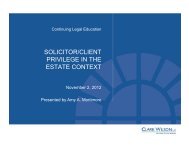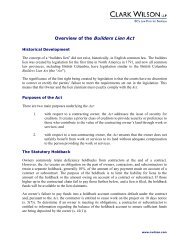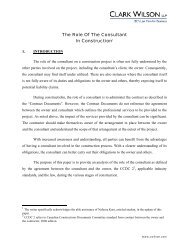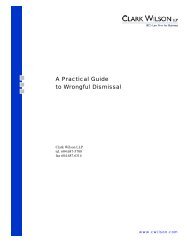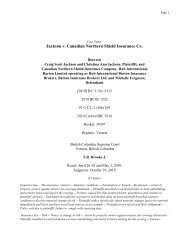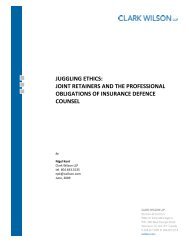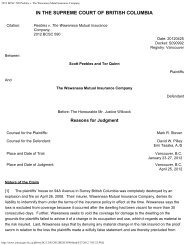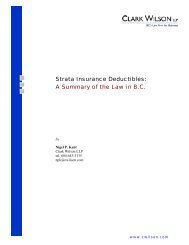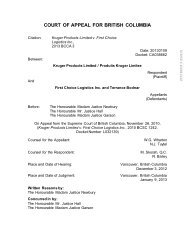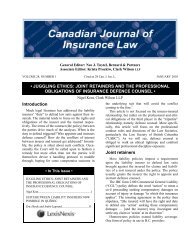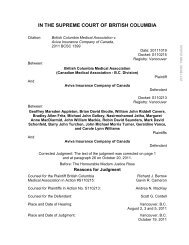AN OVERVIEW OF CONSTRUCTION CLAIMS: - Clark Wilson LLP
AN OVERVIEW OF CONSTRUCTION CLAIMS: - Clark Wilson LLP
AN OVERVIEW OF CONSTRUCTION CLAIMS: - Clark Wilson LLP
You also want an ePaper? Increase the reach of your titles
YUMPU automatically turns print PDFs into web optimized ePapers that Google loves.
p. 28<br />
complete the work and deduct the cost of such work from any amounts which the owner may<br />
thereafter owe the contractor under the contract.<br />
Invoking the general conditions for terminating the contract is often a last resort for an owner.<br />
The cost of terminating the contract with the existing contractor, stopping the work, finding<br />
another contractor who will no doubt charge a hefty amount for completing the work, is often the<br />
not the best or most cost effective method of resolving a dispute and finishing the work.<br />
Furthermore, the owner should also give notice to the bonding company of the default. The<br />
surety is then entitled to a reasonable period of time in order to investigate the situation and then<br />
make a decision on whether to (1) complete the contract in accordance with the terms and<br />
conditions of the contract or (2) obtain bids from contractors for completing the work. In the<br />
meantime, the work on site is stopped and the owner is forced to wait.<br />
From the contractor’s perspective, it is not profitable to be terminated off a project. There are<br />
provisions in the contract permitting an owner to retain the balance of the contract monies for the<br />
incomplete work 50 , to charge the contractor for additional costs associated with completing the<br />
work 51 , and to claim a set-off for any claims made by the contractor for the monies owing under<br />
the contract 52 . There are also concerns as to any damage which may be done to the contractor’s<br />
reputation in the industry.<br />
What should be clear is that all parties benefit from properly drafted contract containing adequate<br />
provisions for alternative dispute resolution, so that disputes can be resolved without having to<br />
resort to the termination provisions under the contract.<br />
10. Indemnification Provisions Under The General Conditions<br />
To indemnify means to guarantee against any loss which another might suffer. For example, two<br />
parties settle a dispute over a contract, and one of them may agree to pay any claims which may<br />
arise from the contract, holding the other harmless.<br />
To hold another party harmless is to promise to pay any costs or claims which may result from<br />
an agreement. Quite often this is part of a settlement agreement, in which one party is concerned<br />
that there might be unknown lawsuits or claims stemming from the situation, so the other party<br />
agrees to cover them.<br />
GC 12.1 provides that the contractor shall indemnify and hold harmless the owner and the<br />
consultant for any claims by third parties that arise out of or are attributable to the contractor’s<br />
performance of the contract. Note, however, the following:<br />
(a)<br />
This indemnity provision is limited to the situations set out in GC 12.1.1, GC<br />
12.1.2, and GC 12.1.3;<br />
50<br />
51<br />
52<br />
GC 5.8.1 and GC 7.1.5.2 of CCDC 2 - 1994<br />
GC 7.1.5.3 and GC 7.1.5.4 of CCDC 2 - 1994<br />
Swagger Construction Ltd. v. U.B.C., 2001 (BCSC – Hood J.)<br />
© 2005 <strong>Clark</strong> <strong>Wilson</strong> <strong>LLP</strong> www.cwilson.com<br />
Samantha Ip, T. 604.643.3172



